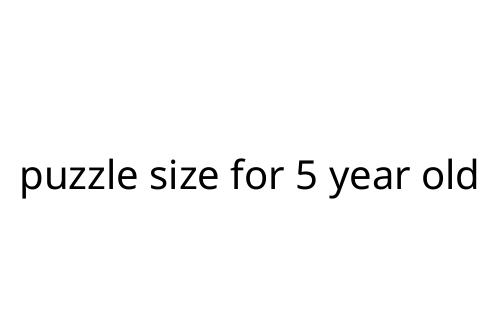puzzle size for 5 year old
Choosing the right puzzle size for a 5 year old can make a big difference in their experience. The right fit keeps things fun and stretches their skills without causing frustration. If you’re looking to pick a puzzle as a gift or an activity, knowing what works best for this age group is worth your time.
Why Puzzle Size Matters
Puzzles offer more than entertainment— they help children build problem-solving skills, patience, and hand-eye coordination. For kids around five, the layout and piece count should feel challenging but not overwhelming. Too many pieces, and the task might seem impossible. Too few, and they get bored quickly.
What’s the Ideal Piece Count?
For a typical 5 year old, look for puzzles with 50 to 100 pieces. This range encourages focused thinking while remaining manageable. At this age, children are usually ready to move beyond chunky wooden puzzles and simple shapes. However, they’re not quite ready for hundreds of tiny jigsaw pieces.
Puzzles within the 50-100 piece count tend to have larger pieces, which help small hands grip and manipulate comfortably. Some kids may stretch up to 120 pieces, especially if they’ve shown strong puzzling skills or lots of enthusiasm.
Quick Reference Guide
- 24-48 pieces: Too simple for most 5 year olds. Suits younger kids.
- 50-100 pieces: The sweet spot for most five-year-olds.
- 100-120 pieces: Good for kids who puzzle often or prefer a challenge.
Other Factors to Consider
Apart from puzzle size for 5 year old, think about the following:
Image complexity: Simple, bold images (like animals or vehicles) are easier to assemble than abstract designs. Kids should recognize the picture and feel excited to complete it.
Piece size and material: Large, sturdy pieces made from cardboard or foam work well for small hands. Avoid tiny, flimsy pieces that bend or get lost.
Theme: Puzzles featuring animals, cartoon characters, or favorite places can hold attention and make the activity feel special.
Pros and Cons of Larger Puzzles
Pros:
- Stimulate problem-solving and concentration
- Build fine motor control
- Offer longer-lasting engagement
Cons:
- Can frustrate if too difficult
- Missing pieces are more likely
- Longer sessions may test patience
Practical Tips for Parents
- Start with fewer pieces if your child is new to puzzles, then gradually increase difficulty.
- Work together at first — demonstrate strategies like sorting edge pieces or grouping by color.
- Store puzzles in bags or containers to keep all pieces together.
- Celebrate each completed puzzle, regardless of size.
Summary
Finding the best puzzle size for 5 year old comes down to balancing challenge and fun. Around 50 to 100 pieces is usually ideal. Consider the child’s interests, their experience level, and choose engaging images with sturdy pieces. With the right puzzle, your child will build skills—and enjoy every step along the way.

 Paulah Simmonserly, the visionary behind News Flip Network, has built a platform that delivers timely and comprehensive news across multiple fields. With a deep passion for journalism and a commitment to keeping the public informed, Simmonserly ensures the site covers everything from global affairs to business trends, health insights, and sports updates. Her leadership emphasizes accuracy and relevance, making News Flip Network a trusted resource for readers seeking up-to-date information on the events shaping the world.
Paulah Simmonserly, the visionary behind News Flip Network, has built a platform that delivers timely and comprehensive news across multiple fields. With a deep passion for journalism and a commitment to keeping the public informed, Simmonserly ensures the site covers everything from global affairs to business trends, health insights, and sports updates. Her leadership emphasizes accuracy and relevance, making News Flip Network a trusted resource for readers seeking up-to-date information on the events shaping the world.